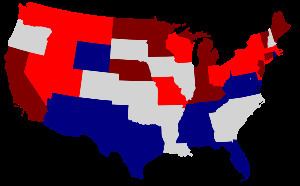38 seats 57 seats 51 45 14,984,498 11,369,078 Start date November 5, 1946 | 39 56 12 11 54.5% 41.4% | |
 | ||
Winner Wallace H White Jr | ||
The United States Senate elections of 1946 were in the middle of Democratic President Harry S. Truman's first term.
Contents
The Republicans took control of the Senate by picking up twelve seats, mostly from the Democrats.
The vote was largely seen as a referendum on Truman, whose approval rating had sunk to 32% over the president's controversial handling of a wave of post-war labor strikes, such as a nationwide railroad strike in May, at a time when Americans depended on train service for both commuter and long-distance travel. Just as damaging was Truman's back-and-forth over whether to end unpopular wartime price controls to handle shortages, particularly in foodstuffs. For example, price controls on beef had led to a "hamburger famine", but when Truman, in a surprise move, lifted the controls on October 14 — just weeks before the election — meat prices shot up to record levels.
Republican wave
The president's lack of popular support is widely seen as the reason for the Democrats' congressional defeat, the largest since they were trounced in the 1928 pro-Republican wave that brought Herbert Hoover to power. And for the first time since before the Great Depression, Republicans were seen as the party which could best handle the American economy.
However, the Republicans also benefited from what today would be called "a good map," meaning that of the one-third of Senate seats up for election, the majority were held by Democrats.
Besides the Republicans being able to hold onto all of their seats, this was the party's largest senate gain since 1920.
Gains and losses
In addition to a net Republican gain by appointment before the election, the Republicans picked up twelve seats, eleven of them from Democrats, and one from Progressive Robert M. La Follette, Jr. (P-WI). This gave them a Senate majority for the first time since Hoover's administration. This election is also notable for the election of Joe McCarthy who would become famous for his investigations of communism in the 1950s.
In addition to capturing open seats in Idaho, Montana, Nevada, and New York, the Republicans defeated seven Democratic incumbents:
